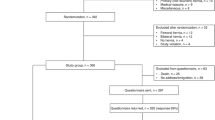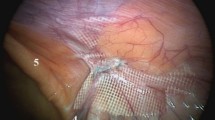Abstract
Introduction
Chronic pain after hernia repair is common, and it is unclear to what extent the different operation techniques influence its incidence. The aim of the present study was to compare the three major standardized techniques of hernia repair with regard to postoperative pain.
Patients and methods
Two hundred and eighty male patients with primary hernias were prospectively, randomly selected to undergo Shouldice, tension-free Lichtenstein or laparoscopic transabdominal pre-peritoneal (TAPP) hernioplasty repairs. Patients were examined after 52 months with emphasis on chronic pain and its limitations to their quality of life.
Results
Chronic pain was present in 36% of patients after Shouldice repair, in 31% after Lichtenstein repair and in 15% after TAPP repair. Pain correlated with physical strain in 25% of patients after Shouldice, in 20% after Lichtenstein and in 11% after TAPP repair. Limitations to daily life, leisure activities and sports occurred in 14% of patients after Shouldice, 13% after Lichtenstein and 2.4% after TAPP repair.
Conclusion
Chronic pain after hernia surgery is significantly more common with the open approach to the groin by Shouldice and Lichtenstein methods. The presence of the prosthetic mesh was not associated with significant postoperative complaints. The TAPP repair represents the most effective approach of the three techniques in the hands of an experienced surgeon.
Similar content being viewed by others
References
Amid PK, Shulman AG, Lichtenstein IL (1996) Open “tension-free” repair of inguinal hernias: the Lichtenstein technique. Eur J Surg 162:447–453
Bittner R, Leibl B, Kraft K, Daubler P, Schwarz J (1996) Laparoscopic hernioplasty (TAPP)—complications and recurrences in 900 operations. Zentralbl Chir 121:313–319
Collaboration EH (2000) Laparoscopic compared with open methods of groin hernia repair: systematic review of randomized controlled trials. Br J Surg 87:860–867
Bay-Nielsen M, Perkins FM, Kehlet H (2001) Pain and functional impairment 1 year after inguinal herniorrhaphy: a nationwide questionnaire study. Ann Surg 233:1–7
Hay JM, Boudet MJ, Fingerhut A, Poucher J, Hennet H, Habib E, Veyrieres M, Flamant Y (1995) Shouldice inguinal hernia repair in the male adult: the gold standard? A multicenter controlled trial in 1578 patients. Ann Surg 222:719–727
Liem MS, van der GY, van Steensel CJ, Boelhouwer RU, Clevers GJ, Meijer WS, Stassen LP, Vente JP, Weidema WF, Schrijvers AJ, van Vroonhoven TJ (1997) Comparison of conventional anterior surgery and laparoscopic surgery for inguinal-hernia repair. N Engl J Med 336:1541–1547
Schmedt CG, Leibl BJ, Bittner R (2002) Endoscopic inguinal hernia repair in comparison with Shouldice and Lichtenstein repair. A systematic review of randomized trials. Dig Surg 19:511–517
Tons C, Kupczyk-Joeris D, Pleye J, Rotzscher VM, Schumpelick V (1990) Cremaster resection in Shouldice repair. A prospective controlled bicenter study. Chirurgie 61:109–111
Amid PK (2002) A 1-stage surgical treatment for postherniorrhaphy neuropathic pain: triple neurectomy and proximal end implantation without mobilization of the cord. Arch Surg 137:100–104
Arlt G, Schumpelick V (2002) The Shouldice repair for inguinal hernia—technique and results. Zentralbl Chir 127:565–569
Broin EO, Horner C, Mealy K, Kerin MJ, Gillen P, O’Brien M, Tanner WA (1995) Meralgia paraesthetica following laparoscopic inguinal hernia repair. An anatomical analysis. Surg Endosc 9:76–78
Callesen T, Bech K, Kehlet H (1999) Prospective study of chronic pain after groin hernia repair. Br J Surg 86:1528–1531
Courtney CA, Duffy K, Serpell MG, O’Dwyer PJ (2002) Outcome of patients with severe chronic pain following repair of groin hernia. Br J Surg 89:1310–1314
Cunningham J, Temple WJ, Mitchell P, Nixon JA, Preshaw RM, Hagen NA (1996) Cooperative hernia study. Pain in the postrepair patient. Ann Surg 224:598–602
Filipi CJ, Gaston-Johansson F, McBride PJ, Murayama K, Gerhardt J, Cornet DA, Lund RJ, Hirai D, Graham R, Patil K, Fitzgibbons R Jr, Gaines RD (1996) An assessment of pain and return to normal activity. Laparoscopic herniorrhaphy vs open tension-free Lichtenstein repair. Surg Endosc 10:983–986
Fingerhut A, Millat B, Bataille N, Yachouchi E, Dziri C, Boudet MJ, Paul A (2001) Laparoscopic hernia repair in 2000. Update of the European Association for Endoscopic Surgery (EAES) Consensus Conference in Madrid, June 1994. Surg Endosc 15:1061–1065
Haapaniemi S, Nilsson E (2002) Recurrence and pain three years after groin hernia repair. Validation of postal questionnaire and selective physical examination as a method of follow-up. Eur J Surg 168:22–28
Heise CP, Starling JR (1998) Mesh inguinodynia: a new clinical syndrome after inguinal herniorrhaphy? J Am Coll Surg 187:514–518
Junge K, Peiper C, Rosch R, Lynen P, Schumpelick V (2002) Effect of tension induced by Shouldice repair on postoperative course and long-term outcome. Eur J Surg 168:329–333
Kumar S, Wilson RG, Nixon SJ, Macintyre IM (2002) Chronic pain after laparoscopic and open mesh repair of groin hernia. Br J Surg 89:1476–1479
Leibl BJ, Kraft B, Redecke JD, Schmedt CG, Ulrich M, Kraft K, Bittner R (2002) Are postoperative complaints and complications influenced by different techniques in fashioning and fixing the mesh in transperitoneal laparoscopic hernioplasty? Results of a prospective randomized trial. World J Surg 26:1481–1484
Schrenk P, Woisetschlager R, Rieger R, Wayand W (1996) Prospective randomized trial comparing postoperative pain and return to physical activity after transabdominal preperitoneal, total preperitoneal or Shouldice technique for inguinal hernia repair. Br J Surg 83:1563–1566
Tons C, Klinge U, Kupczyk-Joeris D, Rotzscher VM, Schumpelick V (1991) Controlled study of cremaster resection in Shouldice repair of primary inguinal hernia. Zentralbl Chir 116:737–743
Wright DM, Kennedy A, Baxter JN, Fullarton GM, Fife LM, Sunderland GT, O’Dwyer PJ (1996) Early outcome after open versus extraperitoneal endoscopic tension-free hernioplasty: a randomized clinical trial. Surgery 119:552–557
Bower S, Moore BB, Weiss SM (1996) Neuralgia after inguinal hernia repair. Am Surg 62:664–667
Fleming WR, Elliott TB, Jones RM, Hardy KJ (2001) Randomized clinical trial comparing totally extraperitoneal inguinal hernia repair with the Shouldice technique. Br J Surg 88:1183–1188
Koninger JS, Oster M, Butters M (1998) Management of inguinal hernia—a comparison of current methods. Chirurgie 69:1340–1344
Tschudi J, Wagner M, Klaiber C, Brugger J, Frei E, Krahenbuhl L, Inderbitzi R, Husler J, Hsu SS (1996) Controlled multicenter trial of laparoscopic transabdominal preperitoneal hernioplasty vs Shouldice herniorrhaphy. Early results. Surg Endosc 10:845–847
Wellwood J, Sculpher MJ, Stoker D, Nicholls GJ, Geddes C, Whitehead A, Singh R, Spiegelhalter D (1998) Randomised controlled trial of laparoscopic versus open mesh repair for inguinal hernia: outcome and cost. Br Med J 317:103–110
Schumpelick V, Treutner KH, Arlt G (1994) Inguinal hernia repair in adults. Lancet 344:375–379
Amid K (2003) The Lichtenstein repair in 2002: an overview of causes of recurrence after Lichtenstein tension-free hernioplasty. Hernia 7:13–16
Bittner R, Schmedt CG, Schwarz J, Kraft K, Leibl BJ (2002) Laparoscopic transperitoneal procedure for routine repair of groin hernia. Br J Surg 89:1062–1066
The MRC Laparoscopic Groin Hernia Trial Group (1999) Laparoscopic versus open repair of groin hernia: a randomised comparison. Lancet 354:185–190
Lal P, Kajla RK, Chander J, Saha R, Ramteke VK (2003) Randomized controlled study of laparoscopic total extraperitoneal versus open lichtenstein inguinal hernia repair. Surg Endosc 17:850–856
Leibl BJ, Daubler P, Schmedt CG, Kraft K, Bittner R (2000) Long-term results of a randomized clinical trial between laparoscopic hernioplasty and Shouldice repair. Br J Surg 87:780–783
Wright D, Paterson C, Scott N, Hair A, O’Dwyer PJ (2002) Five-year follow-up of patients undergoing laparoscopic or open groin hernia repair: a randomized controlled trial. Ann Surg 235:333–337
Zieren J, Zieren HU, Jacobi CA, Wenger FA, Muller JM (1998) Prospective randomized study comparing laparoscopic and open tension-free inguinal hernia repair with Shouldice’s operation. Am J Surg 175:330–333
Nordin P, Bartelmess P, Jansson C, Svensson C, Edlund G (2002) Randomized trial of Lichtenstein versus Shouldice hernia repair in general surgical practice. Br J Surg 89:45–49
Juul P, Christensen K (1999) Randomized clinical trial of laparoscopic versus open inguinal hernia repair. Br J Surg 86:316–319
Bringman S, Ramel S, Heikkinen TJ, Englund T, Westman B, Anderberg B (2003) Tension-free inguinal hernia repair: TEP versus mesh-plug versus Lichtenstein: a prospective randomized controlled trial. Ann Surg 237:142–147
Rosch R, Junge K, Schachtrupp A, Klinge U, Klosterhalfen B, Schumpelick V (2003) Mesh implants in hernia repair. Inflammatory cell response in a rat model. Eur Surg Res 35:161–166
Author information
Authors and Affiliations
Corresponding author
Rights and permissions
About this article
Cite this article
Köninger, J., Redecke, J. & Butters, M. Chronic pain after hernia repair: a randomized trial comparing Shouldice, Lichtenstein and TAPP. Langenbecks Arch Surg 389, 361–365 (2004). https://doi.org/10.1007/s00423-004-0496-5
Received:
Accepted:
Published:
Issue Date:
DOI: https://doi.org/10.1007/s00423-004-0496-5




